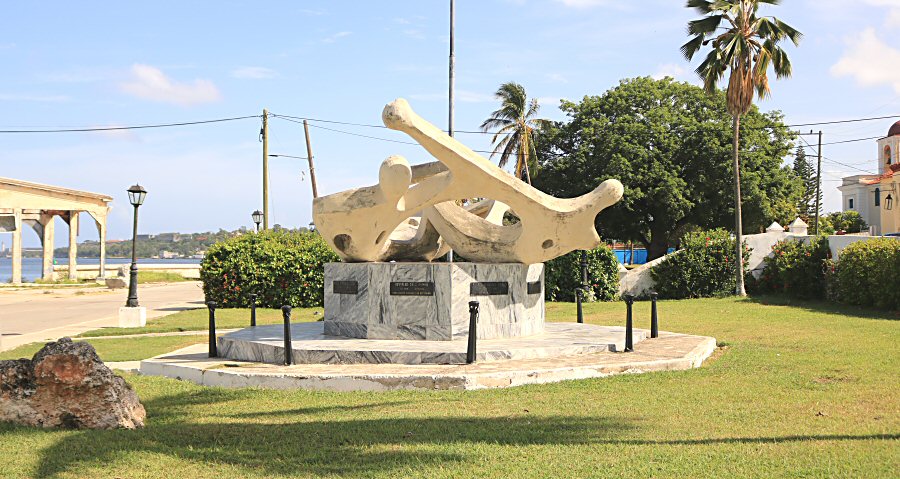Monumento a los Mártires de Regla
The September 12 massacre in Regla, a municipality in
Havana, is one of Batista's countless massacres. Executing
children without trial and torturing women were routine
tasks for Batista's army.
A monument was erected
in El Emboque Square in memory of the September 12
massacre.
Every September 12th, the people of the coastal city make
their way to the cemetery where the remains of the
combatants rest, to lay flowers in memory of those who gave
their lives for the dream of social justice.
HISTORY
A group of young people gathered in Havana's Regla
municipality and were determined to undermine the authority
of Fulgencio Batista, who had established his dictatorship
in a military coup. They decided to carry out sabotage
actions targeting factories, stores, homes, cars, and trucks
belonging to the government and its collaborators, and to
hang symbols and flags of the July 26th movement throughout
the town. The most striking of these actions was the theft
of the Virgin of Regla statue from the church on the eve of
the parade. This final action was planned on September 5,
1958, and was carried out on the same day. By targeting the annual
celebrations held on September 8th in honor of the black
Virgin of Regla, patron saint of Havana Bay they aimed was
to the public that this
was not a time for celebration, given the country's bloody
regime.
After stealing the statue, the rebels stopped at José
Lorenzo Díaz's house to change the cars. After a long
journey, they hid the Virgin in a house under construction
in Víbora Park, in current Arroyo Naranjo.
This action caused a great repercussion, and the festivals
and processions dedicated to the Virgin of Regla on
September 8 were canceled.
The execution
of the informant Leonardo Figueroa del Pino (Tuto)
on August 29, and the execution
of another informant of the Batista's police, Manolo
Sosa (the Watchmaker),
by rebels on September 11th further fueled the anger of the
regime's hitmen and sparked a relentless manhunt.
Among those captured by Batista's forces, Popeye, who broke
down under threats, reported that those wanted were hiding
in a house in the Juanelo neighborhood.
There were indeed four young people (Alberto Álvarez Díaz, Leonardo Valdés, Onelio Dampiel Rodriguez, Reynaldo
Cruz Romeu) were hiding in the Juanelo neighborhood
(today part of San Miguel del Padrón), along with Lydia Doce
Sánchez and Clodomira Acosta Ferrales, two brave women who
had arrived from eastern Cuba on one of the many missions
entrusted to them by the rebel leadership.
On September
12th they heard a knock at the door and Popeye
announced his arrival.
When the door opened, the gang, led by Ventura and Carratalá,
shot the boys, the oldest 23 years old, without any
question.
The heinous attack took place at 16:15 at the building
marked number 217 on Rita Street in the Juanelo
neighborhood, now part of the San Miguel del Padrón
municipality.
The two women were thrown into the army dungeon. Unable to
extract a single word despite intense torture, they were
killed and
thrown into the sea. As sandbags were tied
at their bodies, they disappeared in the depths of the
Havana Bay.
According to some, one of
the women was killed on September 15 and the other on
September 17. Their bodies were never found.
The bodies of the killed boys were buried in Regla
Cemetery under strict security measures to prevent public
reaction.
MONUMENT
The monument, facing the sea and visible to
those who disembark from the traditional passenger boat,
indicates to the visitor that they have arrived in a land of
patriotic traditions.
The statue depicts, like a frozen film strip, the
bodies of the young men shot by Batista's executioners as
they fall to the ground. The holes left by the bullets in
those bodies are, in fact, a source of even greater sorrow
in the public's heart.
It bears the names of six men murdered on
September 12, 1958. It's odd that the women's names are not
included on the monument, as their bodies have not been
recovered. Other plaques also commemorate Bernardino García
Santos, Alberto Fernández Monzón, Leonardo Valdés Suárez,
and Julio A. García Rodríguez, residents of Regla who were
killed in other clandestine operations.
Next to the sculptural motif, a monumental stone
stands, on which appears a bronze plaque with the
inscription: “From the people of Regla to its martyrs.”

